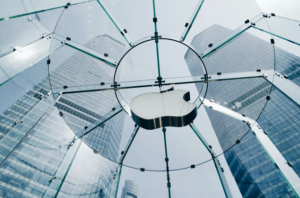
By Jerome Lau, Marketing Director at King’s Commercial Awareness Society
On 26th January, Apple’s current net worth stood at $2.25 trillion, declining by a quarter from a $3 trillion valuation last year. However, trends show that its revenue has continued to grow steadily despite having slowed in recent years.
Apple does not own the factories where its iPhones are made. Instead, the Foxconn Technology Group, a Taiwanese company, produces roughly 70% of all iPhones in their city-sized factory known as ‘iPhone city’ in Zheng Zhou, China, with more than 250,000 workers.
Its success and efficiency largely comes from Apple having spent two decades building a supply chain with a heavy reliance on China that allowed them access to a huge supply-chain network. Further, the ability to scale up production almost overnight kept production costs low while producing high-quality products.
Aside from being cost-effective, a key aspect of Apple’s integration into China has to do with New Product Introduction. This is where new products that Apple or other manufacturing companies release into the market require modifications to pre-existing production lines to ramp up the production of new products.
China exists as one of the few countries which can smoothly carry out the process thanks to policies and encouragement from its government to introduce foreign manufacturing, while simultaneously having a large, cheap and accessible labour pool to support production on such a large scale.
It is for these reasons that Apple has been able to efficiently produce millions of iPhones each year, with China’s geographical advantage being its location to Hong Kong, a global distribution port.
However, Apple faces growing pressure from its investors and US politicians to reduce such reliance on China and to move their manufacturing to other countries. The irony lies in that what was a key strategy to propel Apple to the peak of its success has turned into a weakness.
These rising pressures can be attributed to a multitude of factors, the first being China’s strict zero-COVID strategy, where entire cities were shut down upon the detection of a single case. This understandably severely impacted the productivity of Apple, resulting in worker-shortages at component plants, assembly factories and unusually long wait-times for stock to arrive. This led to Apple being forecasted to experience a shortage of between 5 and 15 million iPhones in 2022.
There are growing trade tensions between China and the US as seen by the US commerce department issuing orders to stop China’s access to advanced semiconductors. With such decisions being made under the basis of Xi Jinping’s decision to tie China’s military reach with its economic development, even more hurdles have been put in place for the production of tech products in China.
While it is true that Apple currently faces a number of issues which threaten to greatly impact its supply-chain in the near future, it is clear that China can no longer serve as Apple’s main production hub. Nevertheless, the strength of Apple’s brand appears strong enough to avoid being significantly affected by such issues.
Places like India or Vietnam have pre-existing manufacturing sectors as well as the labour numbers and talent to potentially meet the demand Apple needs. However, as Apple has established a complex structure with China, it may be difficult to replicate the same success elsewhere.
Enjoyed examining this, very good stuff, regards.
I like this post, enjoyed this one regards for posting. “The basis of optimism is sheer terror.” by Oscar Wilde.